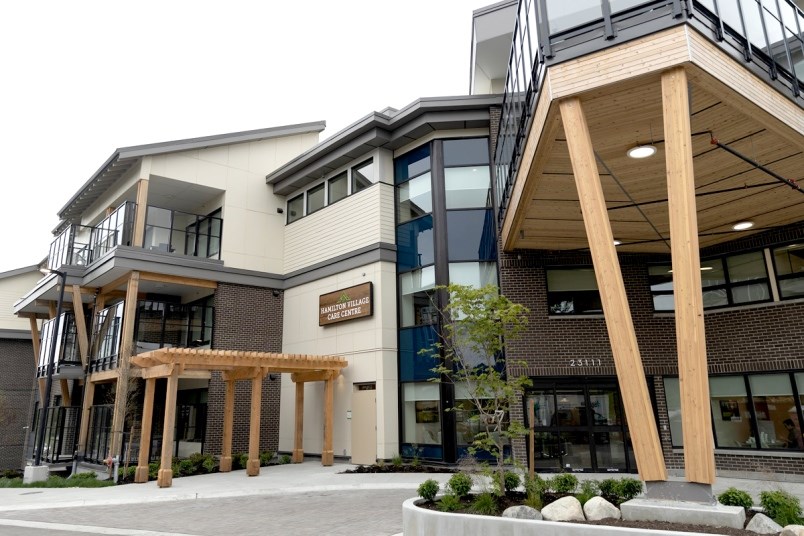A new long-term care facility has opened its doors in east Richmond with gradual entry due to the COVID-19 pandemic.
Hamilton Village Care Centre, a privately owned but publicly funded care home with 135 long-term beds, is taking in two new residents per day.
The new residents are arriving from acute care, other non-outbreak long-term care facilities as well as from the community and they are being initially quarantined for 14 days and screened for symptoms of COVID-19.
Long-term care homes have been under scrutiny during the COVID-19 pandemic because many of the outbreaks have occurred in these facilities.
However, Isobel Mackenzie, the provincial Seniors Advocate, pointed out that nine out of 10 care homes in the province haven’t had COVID-19 cases, and the outbreak response from the health authorities has been swift resulting in good outcomes.
This hasn’t been the case in Ontario where there is a more fragmented health-care system, and where outbreaks were more dire in long-term care facilities, Mackenzie added.
However, there are other systemic problems in long-term care facilities, Mackenzie said, and especially worrisome is the lack of publicly available financial reporting to show how much care residents are receiving.
Hamilton Village Care Centre, owned by Trellis Seniors Services, charges residents 80 per cent of their after-tax income, which is standard for VCH-contracted facilities. The rest of the cost is subsidized by VCH.
Mackenzie pointed out that fewer than half of all care home operators in the province are required to make their audited financial statements available.
Not-for-profit care homes do have to make their statements available, but private companies don’t.
However, these audited statements don’t include expense statements, which detail how much money is being spent on food, labour, equipment and supplies.
According to a report by Mackenzie’s office, entitled “A Billion Reasons to Care” and published earlier this year, care homes receive about $1.3 billion in public funding and, of that, $37 million was generated as profit — $34.4 million by for-profit facilities and $2.8 million by not-for-profits. (The report is based information from 2016/17 and 2017/18.)
The report states private care homes spent 49 per cent on direct care whereas not-for-profits spent 59.
And while each received the same amount of funding, on average, private care homes spent $10,000 — 24 per cent — less per year on care per resident.
There was also an overall discrepancy in the number of direct care hours delivered in the province — according to Mackenzie’s report, for-profit care homes “failed” to deliver 207,000 care hours, while not-for-profits delivered 80,000 hours more than they were funded for.
Mary McDougall, who is one of the owners of Trellis Seniors Care, however, said the company works hard to maintain “strong staffing levels” by building a good team of employees.
Also, if the company can’t find staff for the hours they are contracted for, it will voluntarily give back that funding to the health authority, she said. However, it is under no obligation to do so, and other private operators may feel differently.
McDougall pointed out they are audited by the health authority to make sure they’re in compliance with their contract and, by way of their contract, they are a “public service.”
However, while the word “efficient” has become a code word for “cheaper” in delivering long-term care, Mackenzie doesn’t agree it’s possible to make things more efficient and still maintain a good quality of life.
“At the end of the day, when you think about what adds meaning to the life of somebody in a care home — you cannot ‘efficiencize’ …it to be better,” she said. “It is about literally how much time you spend with that person.”
This might be time spent talking to a senior about their life or helping them into a wheelchair, Mackenzie said.
“It’s about time, it’s about personal time — and that equals money,” she added.
Mackenzie argues in her report that public money should be used to provide as many care hours as possible, and the financial incentive to do otherwise should be eliminated. If a care home can hire people for lower wages, the surplus funds should be used for more care hours — or the funding should be returned, she added.
McDougall said Trellis is “fully compliant” with the hours they are contracted to provide at their current facility in Kamloops, Gemstone, and will provide at their other facilities. (Trellis is currently building a long-term care facility in North Vancouver as well.)
She added, they use best practises and self-audit. They also rely on external accreditation to make sure they offer “above baseline” care.
“We work really hard to ensure a high quality of care,” McDougall said.
Mackenzie said there are many good long-term care homes in B.C., but there are also gaps in the system outside institutional facilities.
One solution she suggests is investing money into home care instead of care homes — keeping more people in their homes, which many would prefer, could ease up the waitlist for those who really need the institutional setting.



